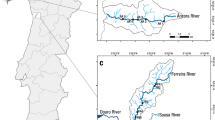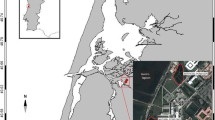Abstract
Biomarkers have been widely employed in ecotoxicology as early warning indicators of exposure to toxicants. Very often, they are used to compare reference and polluted sites, or to analyse time trends. However, very few studies focus on the natural variability range of biomarkers in the environment, which is pivotal to understand if the detected differences are actually determined by any adverse effects due to pollution. This work assesses the natural spatio-temporal variability of some enzymatic levels, frequently used as biomarkers, in freshwater benthic invertebrates. The influence of some environmental parameters on the enzymatic levels was also evaluated. Three families of insect larvae (Perlidae, Baetidae, and Heptageniidae) were sampled in three pristine streams and in eight different dates. Four enzymes (acetylcholinesterase, glutathione-S-transferase, alkaline phosphatase, and catalase) were measured. The natural variability of enzymatic levels was often significant in all considered species across both space and time. The observed pattern was poorly explained by the monitored environmental parameters. The results of this work show that great care should be paid when interpreting monitoring data in which biomarker levels are measured and compared among sites or dates. Presuming that measured differences are due to anthropogenic factors can be misleading, when other potentially influencing factors have not been accounted for.



Similar content being viewed by others
References
Amiard-Triquet C, Berthet B (2015) Individual biomarkers. In: Aquatic ecotoxicology: advancing tools for dealing with emerging risks (eds. C. Amiard-Triquet, J-C. Amiard & C. Mouneyrac), pp. 153–182. Academic.
Ankley GT, Daston GP, Degitz SJ, Denslow ND, Hoke RA, Kennedy SW, Miracle AL, Perkins EJ, Snape J, Tillit DE, Tyler CR, Versteeg D (2006) Toxicogenomics in regulatory ecotoxicology. Environmental Science & Technology 40:4055–4065
APHA, AWWA, WEF (1998) Standard methods for the examination of water and wastewater, XX edn. Washington, APHA
Ball M, Somers G, Wilson JE, Tanna R, Chung C, Duro DC, Seitz N (2013) Scale, assessment components, and reference conditions: issues for cumulative effects assessment in Canadian watersheds. Integr Environ Assess Manag 9:370–379
Barata C, Lekumberri I, Villa-Escalé M, Prat N, Porte C (2005) Trace metal concentration, antioxidant enzyme activities and susceptibilities to oxidative stress in the tricoptera larvae Hydropsyche exocellata from the Llobregat river basin (NE Spain). Aquat Toxicol 74:3–19
Barata C, Damasio J, López MA, Kuster M, de Alda M L, Barceló D, MC R, Raldúa D (2007) Combined use of biomarkers and in situ bioassays in Daphnia magna to monitor environmental hazards of pesticides in the field. Environ Toxicol Chem 26(2):370–379
Bayne BL, Livingstone DR, Moore MN, Widdows J (1976) A citochemical and biochemical index of stress in Mytilus edulis. Mar Pollut Bull 7:221–229
Bergmeyer HU, Grassl M (1983) Catalase. In: Methods of enzymatic analysis (ed H.U. Bergmeyer), pp. 165–166. Academic Press, New York and London.
Berra E, Forcella M, Giacchini R, Marziali L, Rossaro B, Parenti P (2004) Evaluation of enzyme biomarkers in freshwater invertebrates from Taro and Ticino river, Italy. Annales de Limnologie—International Journal of Limnology 40:169–180
Berra E, Forcella M, Giacchini R, Rossaro B, Parenti P (2006) Biomarkers in caddisfly larvae of the species Hydropsyche pellucidula (Curtis, 1834) (Trichoptera: Hydropsychidae) measured in natural populations and after short term exposure to fenitrothion. Bull Environ Contam Toxicol 76:863–870
Binelli A, Ricciardi F, Riva C, Provini A (2005) Screening of POP pollution by AChE and EROD activities in zebra mussels from the Italian Great Lakes. Chemosphere 61:1074–1082
Bonzini S, Finizio A, Berra E, Forcella M, Parenti P, Vighi M (2008) Effects of river pollution on the colonisation of artificial substrates by macrozoobenthos. Aquat Toxicol 89:1–10
Bradford MM (1976) A rapid and sensitive method for the quantitation of protein utilizing the principle of dye-protein binding. Anal Biochem 72:248–254
Callaghan A, Fisher TC, Grosso A, Holloway GJ, Crane M (2002) Effect of temperature and pirimiphos methyl on biochemical biomarkers in Chironomus riparius Meigen. Ecotoxicol Environ Saf 52:128–133
Clements WH, Newman MC (2002) Application of multimetric and multivariate approaches in community ecotoxicology. In: Clements WH, Newman MC (eds) Community ecotoxicology. Wiley, Ltd, Chichester, pp 141–166
Core Team R (2014) R: a language and environment for statistical computing. R Foundation for Statistical Computing, Vienna. http://www.R-project.org
Crane M, Sildanchandra W, Kheir R, Callaghan A (2002) Relationship between biomarker activity and developmental endpoints in Chironomus riparius Meigen exposed to an organophosphate insecticide. Ecotoxicol Environ Saf 53:361–369
Crowe TP, Smith EL, Donkin P, Barnaby DL, Rowland SJ (2004) Measurements of sublethal effects on individual organisms indicate community-level impacts of pollution. J Appl Ecol 41:1365–2664
Damásio J, Tauler R, Teixidó E, Rieradevall M, Prat N, Riva MC, Soares AMVM, Barata C (2008) Combined use of Daphnia magna in situ bioassay, biomarkers and biological indices to diagnose and identify environmental pressures on invertebrate communities in two Mediterranean urbanized and industrialized rivers (NE Spain). Aquat Toxicol 87:310–320
Damásio J, Fernandez-Sanjuan M, Sanchez-Avila J, Lacorte S, Prat N, Rieradevall M, Soares AMVM, Barata C (2011) Multi-biochemical responses of benthic macroinvertebrate species as a complementary tool to diagnose the cause of community impairment of pollute drivers. Water Res 45:3599–3613
De la Vega Salazar MY, Martínez Tabche L, Macías Garcia C (1997) Bioaccumulation of methyl parathion and its toxicology in several species of the freshwater community in Ignacio Ramirez Dam in Mexico. Ecotoxicol Environ Saf 38:53–62
EFSA (2006) Conclusion regarding the peer review of the pesticide risk assessment of the active substance fenitrothion. EFSA Jounal 4(2)
EFSA (2010) Scientific opinion on the development of specific protection goal options for environmental risk assessment of pesticides, in particular in relation to the revision of the Guidance Documents on Aquatic and Terrestrial Ecotoxicology (SANCO/3268/2001 and SANCO/10329/2002). EFSA J 8:1821
Faria M, Ochoa V, Blázquez M, San Juan MF, Lazzara R, Lacorte S, Soares AMVM, Barata C (2014) Separating natural from anthropogenic causes of impairment in Zebra mussel (Dreissena polymorpha) populations living across a pollution gradient. Aquat Toxicol 152:82–95
Forbes VE, Calow P (2012) Promises and problems for the new paradigm for risk assessment and an alternative approach involving predictive systems models. Environ Toxicol Chem 31:2663–2671
Forbes VE, Palmquist A, Bach L (2006) The use and misuse of biomarkers in ecotoxicology. Environ Toxicol Chem 25:272–280
Habig WH, Pabst MJ, Jakoby WB (1974) Glutathione S-transferases. The first enzymatic step in mercapturic acid formation. The Journal of Biological Chemistry 249:7130–7139
Hommen U, Baveco JM, Galic N, Van den Brink PJ (2010) Potential application of ecological models in the European environmental risk assessment of chemicals: I. Review of protection goals of EU directives. Integr Environ Assess Manag 6:325–337
Key PB, Fulton MH, Harman-Fetcho JA, McConell LL (2003) Acetylcholinesterase activity in grass shrimp and aqueous pesticide levels from South Florida drainage canals. Arch Environ Contam Toxicol 45:371–377
Koenig S, Solé M (2012) Natural variability of hepatic biomarkers in Mediterranean deep-sea organisms. Mar Environ Res 79:122–131
Legendre P, Oksanen J, ter Braak CJF (2011) Testing the significance of canonical axes in redundancy analysis. Methods Ecol Evol 2:269–277
Martyniuk CJ, Griffitt RJ, Denslow ND (2011) Omics in aquatic toxicology: not just another microarray. Environ Toxicol Chem 30:263–264
Menezes S, Soares AMVM, Guilhermino L, Peck MR (2006) Biomarker responses of the estuarine brown shrimp Crangon crangon L. to non-toxic stressors: temperature, salinity and handling stress effects. J Exp Mar Biol Ecol 335:114–122
Mitchelmore CL, Rowe CL, Place AR (2006) Tools for assessing contaminant exposure and effects in reptiles. In: Toxicology of reptiles (eds S.C. Gardner & E. Oberdörster), pp. 63–122. CRC Press, Taylor & Francis Group, Boca Raton, FL, USA.
Oksanen J, Blanchet FG, Kindt R, Legendre P, Minchin PR, O’Hara RB, Simpson GL, Solymos P, Stevens MHH, Wagner H (2013) Vegan: community ecology package. R package version 2 :–7Available at http://CRAN.R-project.org/package=vegan
Olsen T, Ellerbeck L, Fisher T, Callaghan A, Crane M (2001) Variability in acetylcholinesterase and glutathione-S-transferase activities in Chironomus riparius Meigen deployed in situ at uncontaminated field sites. Environ Toxicol Chem 20:1725–1732
Payne JF (1977) Mixed function oxidases in marine organisms in relation to petroleum hydrocarbons metabolism and detection. Mar Pollut Bull 8:112–121
Peakall DB (1976) Effects of toxaphene in epatic enzyme induction and circulating steroid levels in the rat. Environ Health Perspect 13:117–125
Pereira CD, Martín-Díaz ML, Catharino MG, Cesar A, Choueri RB, Taniguchi S, Abessa DM, Bícego MC, Vasconcellos MB, Bainy AC, Sousa EC, Delvalls TA (2010) Chronic contamination assessment integrating biomarkers’ responses in transplanted mussels—a seasonal monitoring. Environ Toxicol 27:257–267
Pestana JLT, Novais SC, Lemos MFL, Soares AMVM (2014) Cholinesterase activity in the caddisfly Sericostoma vittatum: biochemical enzyme characterization and in vitro effects of insecticides and psychiatric drugs. Ecotoxicol Environ Saf 104:263–268
Pfeifer S, Schiedek D, Joachim T, Dippner W (2005) Effect of temperature and salinity on acetylcholinesterase activity, a common pollution biomarker, in Mytilus sp. from the south-western Baltic Sea. J Exp Mar Biol Ecol 320:93–103
Prat N, Rieradevall M, Barata C, Munné A (2013) The combined use of metrics of biological quality and biomarkers to detect the effects of reclaimed water on macroinvertebrate assemblages in the lower part of a polluted Mediterranean river (Llobregat River, NE Spain). Ecol Indic 24:167–176
Printes LB, Callaghan A (2003) Intraclonal variability in Daphnia acetylcholinesterase activity: the implications for its applicability as a biomarker. Environ Toxicol Chem 22:2042–2047
Scarduelli L, Giacchini R, Parenti P, Migliorati S, Di Brisco A, Vighi M (2016) Natural variability of biochemical biomarkers in the macro-zoobenthos: dependence on life stage and environmental factors. SETAC Europe 26th Annual Meeting. Nantes, 22–26 May 2016 (full paper submitted).
Schmidt W, Power E, Quinn B (2013) Seasonal variations of biomarker responses in the marine blue mussel (Mytilus spp.). Mar Pollut Bull 74:50–55
Serafim A, Company R, Lopes B, VF F, Franc S, RP V, MJ B, HN C (2012) Application of an integrated biomarker response index (IBR) to assess temporal variation of environmental quality in two Portuguese aquatic systems. Ecol Indic 19:215–225
Suter GW (1993) A critique of ecosystem health concepts and indexes. Environ Toxicol Chem 12:1533–1539
Timbrell JA (1998) Biomarkers in toxicology. Toxicology 129:1–12
Tu HT, Silvestre F, Meulder BD, Thome JP, Phuong NT, Kestemont P (2012) Combined effects of deltamethrin, temperature and salinity on oxidative stress biomarkers and acetylcholinesterase activity in the black tiger shrimp (Penaeus monodon). Chemosphere 86:83–91
Van Aggelen G, Ankley GT, Baldwin WS, Bearden DW, Benson WH, Chipman JK, Collette TW, Craft JA, Denslow ND, Embry MR, Falciani F, George SG, Helbing CC, Hoekstra PF, Iguchi T, Kagami Y, Katsiadaki I, Kille P, Liu L, Lord PG, McIntire T, O’Neill A, Osachoff H, Prkins EJ, Santos EM, Skirrow RC, Snape JR, Tyler CR, Versteeg D, Viant MR, Volz DC, Williams TD, Yu L (2010) Integrating omic technologies into aquatic ecological risk assessment and environmental monitoring: hurdles, achievements, and future outlook. Environ Health Perspect 118:1–5
Wernersson A-S, Carere M, Maggi C, Tusil P, Soldan P, James A, Sanchez W, Dulio V, Broeg K, Reifferscheid G, Buchinger S, Maas H, Van Der Grinten E, O’Toole S, Ausili A, Manfra L, Marziali L, Polesello S, Lacchetti I, Mancini L, Lilja K, Linderoth M, Lundeberg T, Fjällborg B, Porsbring T, Larsson JDG, Bengtsson-Palme J, Förlin L, Kienle C, Kunz P, Vermeirssen E, Werner I, Robinson CD, Lyons B, Katsiadaki I, Whalley C, den Haan K, Messiaen M, Clayton H, Lettieri T, Negrão Carvalho R, Gawlik BM, Hollert H, Di Paolo C, Brack W, Kammann U, Kase R (2015) The European technical report on aquatic effect-based monitoring tools under the water framework directive. Environmental Sciences Europe, 27.
Acknowledgments
The authors are grateful to Rachel Sharp for revising the manuscript.
Author information
Authors and Affiliations
Corresponding author
Additional information
Responsible editor: Cinta Porte
Supporting Information
Online Resource 1
Barplot summarising the monitored physical-chemical parameters of the stream water. (PDF 6 kb)
Online Resource 2
Full dataset used for the analyses in the present paper. (XLSX 37 kb)
Rights and permissions
About this article
Cite this article
Ippolito, A., Giacchini, R., Parenti, P. et al. Natural variability of enzymatic biomarkers in freshwater invertebrates. Environ Sci Pollut Res 24, 732–742 (2017). https://doi.org/10.1007/s11356-016-7833-4
Received:
Accepted:
Published:
Issue Date:
DOI: https://doi.org/10.1007/s11356-016-7833-4




